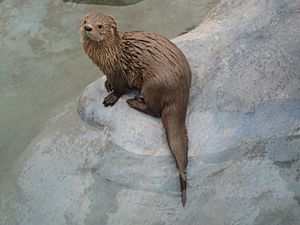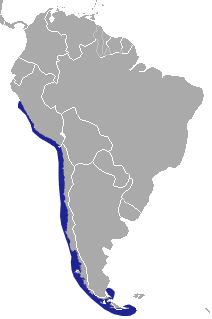Marine otter facts for kids
Quick facts for kids Marine otter |
|
|---|---|
 |
|
| Conservation status | |
| Scientific classification | |
| Genus: |
Lontra
|
| Species: |
felina
|
 |
|
| Marine otter range | |
The marine otter (Lontra felina) is a type of otter. It is also known as the "chungungo" in some parts of South America. This special otter lives only in salty ocean water along the coast. You will find it in places where the land meets the sea. It almost never goes into rivers or river mouths.
Contents
What is a Marine Otter?
Marine otters are the smallest marine mammal in South America. They are part of the weasel family, which includes animals like badgers and ferrets. These otters are very good swimmers and spend most of their lives in the ocean. They are well-adapted to living in cold coastal waters.
Physical Features of Marine Otters
Marine otters have a sleek, dark brown fur coat. Their fur is lighter on their belly, often a grayish-brown color. This thick fur helps keep them warm in the chilly ocean. They have a long, muscular tail that helps them steer when swimming. Their feet are webbed, which makes them excellent swimmers. An adult marine otter can grow to about 1 meter (3.3 feet) long, including its tail. They usually weigh between 3 and 5 kilograms (6.6 to 11 pounds).
Where Do Marine Otters Live?
Marine otters live along the Pacific coast of South America. Their home range stretches from central Peru down to Tierra del Fuego in southern Chile and Argentina. They prefer rocky coastlines with lots of hiding spots. These spots include caves, crevices, and dense kelp forests. They need places to rest, raise their young, and escape from predators.
Marine Otter Habitat
These otters are found in the intertidal zone. This is the area of the coast that is covered by water at high tide and exposed at low tide. They often live near areas with strong waves and currents. This makes it harder for predators to find them. They rarely go far from the shore, usually staying within 100 meters (330 feet) of the land.
What Do Marine Otters Eat?
Marine otters are carnivores, meaning they eat meat. Their diet mainly consists of small animals found in the ocean. They are skilled hunters and divers.
Marine Otter Diet
Their favorite foods include crabs, shrimp, and other crustaceans. They also eat different types of fish, molluscs like clams and snails, and even octopus. Marine otters use their strong teeth to crush the shells of their prey. They often bring their food to the surface to eat it. Sometimes, they use rocks as tools to break open hard shells.
Marine Otter Behavior
Marine otters are mostly active during the day. They are often seen alone or in small family groups. These groups usually consist of a mother and her pups. They are quite shy and can be hard to spot.
Social Life of Marine Otters
Unlike some other otter species, marine otters are not very social. They prefer to live alone or in very small groups. They communicate with each other using various sounds, like chirps and whistles. They also use scent marking to show their territory.
Resting and Grooming
When not hunting, marine otters spend time resting on rocks or in their dens. They are very clean animals. They spend a lot of time grooming their fur. This helps to keep their fur waterproof and insulating, which is vital for staying warm in the cold ocean.
Reproduction and Life Cycle
Marine otters usually mate between December and January. After mating, the female otter will carry her babies for about 60 to 65 days.
Birth and Raising Pups
A female marine otter typically gives birth to one to four pups. The pups are born in a hidden den, often in a rocky crevice. They are born blind and helpless. The mother otter takes care of her pups for about 10 months. During this time, she teaches them how to swim, hunt, and survive in the ocean. The pups stay with their mother until they are strong enough to live on their own. Marine otters can live for about 10 years in the wild.
Conservation Status
The marine otter is an endangered species. This means their numbers are very low, and they face a high risk of extinction. Many things threaten their survival.
Threats to Marine Otters
- Habitat Loss: Coastal development and pollution destroy their natural homes.
- Illegal Hunting: They are sometimes hunted for their fur or because they are seen as a pest by fishermen.
- Pollution: Oil spills and other types of ocean pollution can harm or kill otters and their food sources.
- Overfishing: A lack of fish and other prey due to overfishing can make it hard for otters to find enough food.
- Climate Change: Changes in ocean temperatures and sea levels can also affect their habitat and food supply.
Protecting Marine Otters
Many efforts are being made to protect marine otters. These include creating protected marine areas, educating local communities, and enforcing laws against illegal hunting. It is important to protect these unique animals so they can continue to thrive in their coastal homes.
See also
 In Spanish: Chungungo para niños
In Spanish: Chungungo para niños


